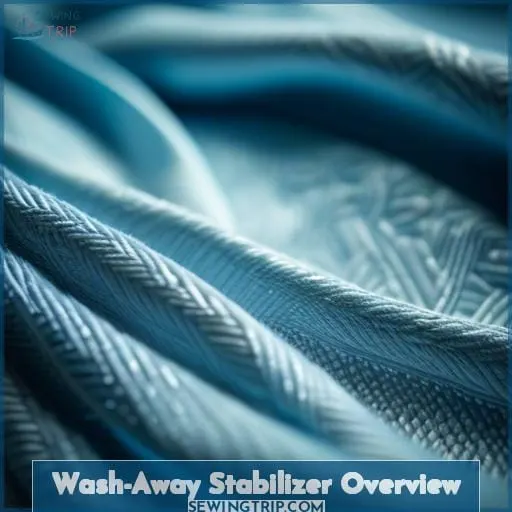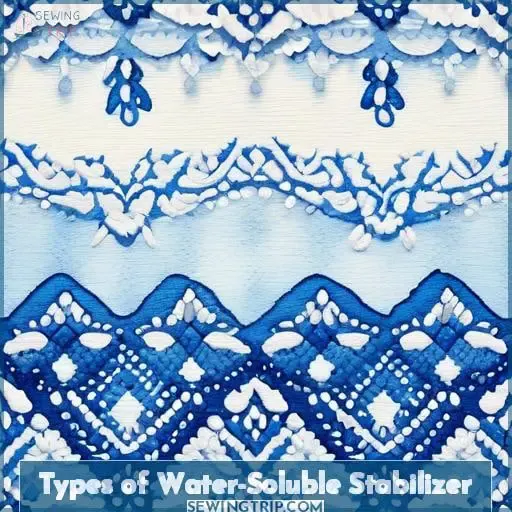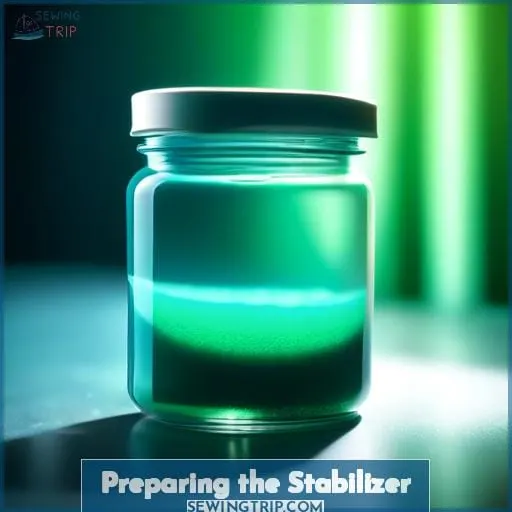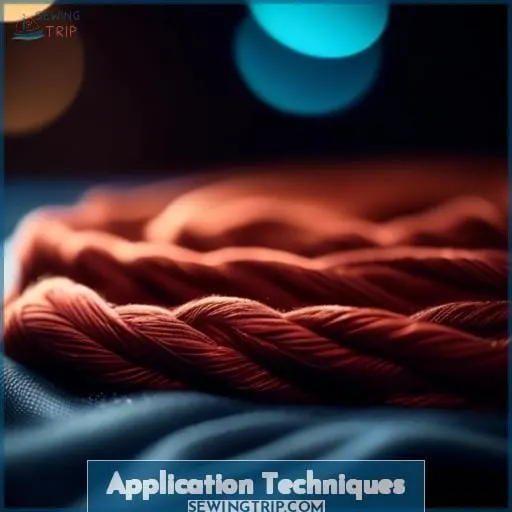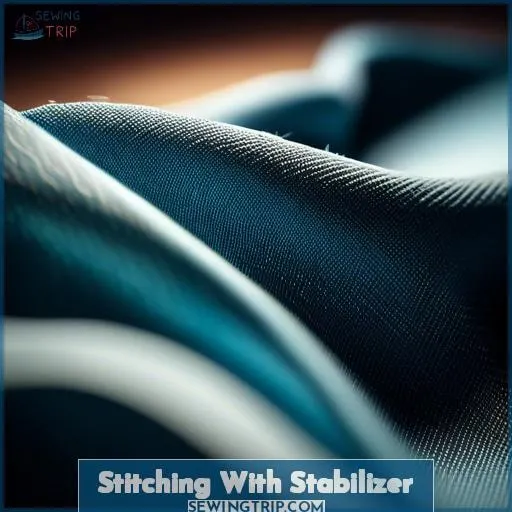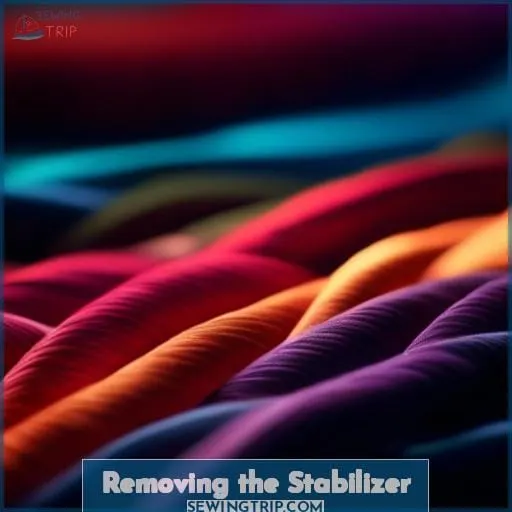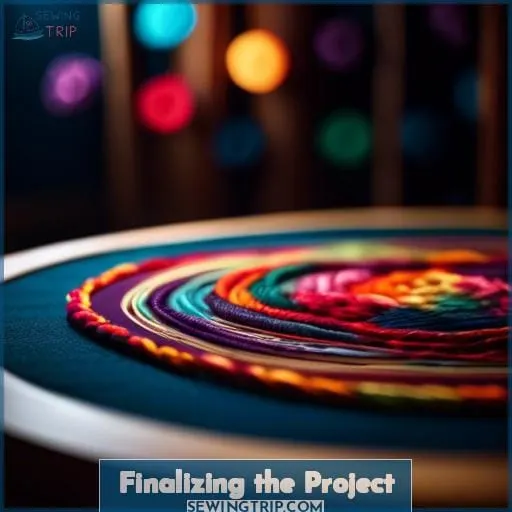This site is supported by our readers. We may earn a commission, at no cost to you, if you purchase through links.
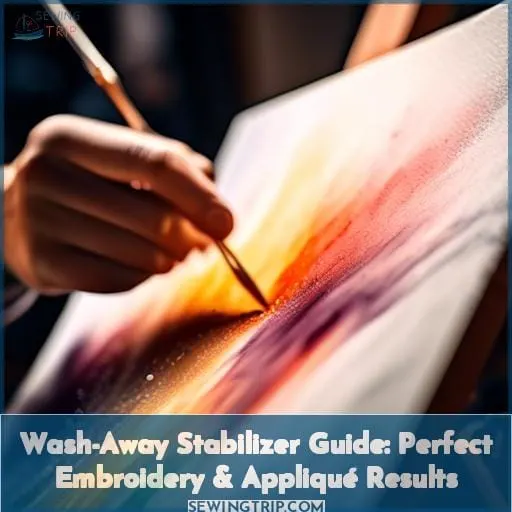
Dive into the world of wash-away stabilizer and discover how it can elevate your projects to the realm of perfection, ensuring every stitch is precisely where it should be.
Yes, to use wash away stabilizer, place it on top of high pile fabrics before stitching to prevent stitches from sinking and hoop it with the fabric, then remove and wash away the excess after stitching.
Wash away stabilizers dissolve in water and are ideal for delicate fabrics or when the stabilizer should not be visible after the project is completed.
Table Of Contents
Key Takeaways
- Wash away stabilizers are ideal for projects where no stabilizer remnants are desired, such as with sheer fabrics or when the back of the work is visible.
- Adhesive-backed wash away stabilizer sheets can be printed on directly from a computer, simplifying the transfer of embroidery designs onto the stabilizer.
- The stabilizer provides support for delicate fabrics and intricate embroidery patterns, preventing fabric puckering and ensuring design precision.
- After embroidery, the stabilizer is easily removed by rinsing the fabric under water or soaking it, leaving a clean finish without damaging the fabric.
Wash-Away Stabilizer Overview
Amy Marson highly recommends the Wash-Away Stitch Stabilizer for embroidery and appliqué projects, emphasizing its ease of use and effectiveness.
This stabilizer is designed to provide extra stability for delicate fabrics and dense embroidery patterns, making it an ideal choice for a wide range of creative endeavors. Its adhesive-backed sheets can be printed on directly from a computer, allowing for precise design placement.
After the embroidery is complete, the stabilizer dissolves completely in water, leaving behind a professional-looking finished product without any residue. This feature is particularly beneficial for projects where the back of the work is visible or for delicate items that can’t withstand the weight or bulk of traditional stabilizers.
Recommended by Amy Marson
Amy Marson highly recommends wash-away stabilizer for its user-friendly and newbie-friendly qualities.
This economical, waste-reducing option is a time-saver in your embroidery toolkit. Whether you’re using Sulky Solvy for delicate projects or Sulky Ultra Solvy for heavier tasks, this water-soluble stabilizer ensures your embroidery stabilizer needs are met with ease and efficiency.
Ideal for Embroidery and Appliqué
Wash-Away stabilizer is ideal for embroidery and appliqué projects. Its adhesive-backed sheets allow easy application to fabrics before stitching.
This prevents distortion of delicate fabrics during dense embroidery work. The result is a smooth, professional-looking finish for your embroidery and appliqué creations, whether an intricate free-standing lace design or a simple fabric appliqué.
With Wash-Away, your embroidery stitches stay locked in place for flawless results.
Types of Water-Soluble Stabilizer
The two main types of water-soluble stabilizer are film-like and fibrous paper-like. Film-like stabilizer is thin, lightweight, and perfect to use as a topper. It prevents stitches from sinking into fabric and can be floated on top or hooped with fabric.
Fibrous paper-like stabilizer is thicker and more suited as a backing. It provides stability for intricate embroidery designs and keeps the back clean.
- Film-like: lightweight, goes on top
- Fibrous: heavier, used as backing
- Film prevents stitches sinking in
- Fibrous supports intricate designs
- Film floated or hooped on top
- Fibrous prevents messy backs
Water-soluble stabilizers dissolve completely in water, unlike tear-away and cut-away stabilizers. With the right technique, water-soluble stabilizers produce professional embroidery results without leaving any evidence behind.
Preparing the Stabilizer
When preparing to use wash-away stitch stabilizer for your embroidery or appliqué projects, it’s essential to understand how to handle these adhesive-backed sheets effectively.
You can print your designs directly onto the stabilizer sheets using a standard printer, offering a precise guide for your stitching.
After printing, simply peel off the backing to expose the adhesive side and press it onto your fabric, ensuring it aligns with your intended design area.
This process not only streamlines the preparation phase but also guarantees that your fabric is adequately supported, especially when working with delicate materials or intricate patterns.
Printing Designs
To achieve precise design placement and printing accuracy on wash-away stabilizer, it’s essential to calibrate your printer and ensure stabilizer alignment. When printing directly onto the stabilizer, consider the type of stabilizer—film-like or fibrous paper-like—and the intended use, whether as a topping or backing.
For image transfer, printers should be set to handle the stabilizer’s material without smudging or misalignment. After printing, the adhesive-backed stabilizer can be applied to the fabric, ready for embroidery.
If using liquid or spray stabilizer, ensure even coverage for a smooth stitching surface.
| Step | Consideration | Tip |
|---|---|---|
| Calibration | Printer settings | Ensure compatibility with stabilizer type |
| Printing | Design accuracy | Check image alignment and quality |
| Application | Stabilizer alignment | Align with fabric and design placement |
| Usage | Type of stabilizer | Choose film-like or fibrous based on project |
| Removal | Water solubility | Use water to dissolve stabilizer after stitching |
Applying Adhesive-backed Sheets
After printing your designs onto wash-away stabilizer sheets, it’s time to apply them to your fabric.
Peel off the backing to expose the adhesive, ensuring a secure placement without the need for temporary spray adhesive or pins. This step is crucial for hand sewing or machine embroidery, as it prevents the fabric from puckering and allows for precise backing.
For knit fabric, this method helps maintain the material’s shape. If any excess stabilizer remains after stitching, a seam-fix remover or a damp paper towel can aid in its removal before ironing.
Application Techniques
When it comes to achieving perfect results in your embroidery and appliqué projects, understanding how to effectively use wash-away stabilizer is key.
As a topping, it’s essential for preventing stitches from sinking into plush fabrics, ensuring your design remains visible and crisp.
As a backing, it provides the necessary support for delicate fabrics and intricate designs, preventing puckering and distortion.
Whether you’re working on a project that requires a clean finish with no stabilizer residue or dealing with hard-to-hoop items, mastering these application techniques will elevate the quality of your work.
As a Topping
Using wash-away stabilizer as a topping is a game-changer for your embroidery projects. When you’re dealing with high-pile fabrics like terry cloth or fleece, a lightweight wash-away topping is your ally.
It prevents your stitches from sinking into the fabric, ensuring they stand out beautifully. Simply float the topping over the fabric, securing it with a temporary adhesive, pins, or tape.
After your masterpiece is complete, a quick soak or a pass under the tap, and the topping dissolves away. For a crisp finish, lay a damp paper towel over the design and press with an iron—no steam, of course.
As a Backing
Use wash-away stabilizer as a backing when embroidering intricate designs or on delicate fabrics. Hoop it behind the fabric for stability. Or float it atop hooped tear-away for extra support.
With dense stitches, directly hoop just the wash-away and embroider right on it. It prevents picking out little bits after.
Compared to tear-away, it dissolves cleanly in water using a tennis ball.
Smart backing choice for your machine embroidery.
Stitching With Stabilizer
When you’re working with delicate fabrics or aiming for dense embroidery patterns, using a wash-away stabilizer can be a game-changer.
It’s essential to ensure your fabric stays put and doesn’t pucker or distort as you stitch. By applying a wash-away stabilizer, you’re giving your project the necessary support to handle the embroidery process smoothly, resulting in a professional-looking finish that’s free of puckers and wrinkles.
Preventing Fabric Puckering
To prevent fabric puckering when using wash-away stabilizer, proper fabric preparation is key.
The hooping method should provide a firm base without distorting the fabric’s natural state. For fabrics prone to stretching, consider the float technique, placing the stabilizer beneath the hooped fabric for additional support.
Stabilizer placement is crucial; it should cover the entire area of the design to prevent fabric stretching and distortion during the embroidery process.
Achieving Dense Embroidery Patterns
When aiming for dense embroidery patterns, the right stabilizer density is crucial. It provides the necessary stitch support, ensuring intricate designs maintain their shape on delicate fabrics.
A professional finish hinges on the stabilizer’s ability to prevent fabric puckering and distortion. Select a stabilizer that complements the fabric weight and design complexity for optimal results.
Removing the Stabilizer
When it comes to removing your wash-away stitch stabilizer, the process is straightforward and ensures your embroidery or appliqué project retains its pristine appearance.
After completing your stitching, simply rinse the fabric under water or soak it for a few minutes to dissolve the stabilizer completely. This method is particularly effective for delicate fabrics and dense embroidery patterns, preventing puckering and distortion, and leaving you with a smooth, professional-looking finish.
Rinsing Under Water
Wash-away stabilizers are a game-changer for embroidery and appliqué projects, offering a unique blend of versatility and convenience. Highly recommended by Amy Marson, these stabilizers are ideal for working with delicate fabrics and achieving dense embroidery patterns without the risk of puckering or distortion.
They come in adhesive-backed sheets, making application straightforward: simply print or trace your design onto the stabilizer, peel off the backing, and apply it to your fabric. After stitching, the stabilizer dissolves completely in water, leaving a professional-looking finish.
There are two main types of water-soluble stabilizer: film-like and fibrous paper-like. The film-like variety is lightweight and perfect as a topper to prevent stitches from sinking into the fabric, while the fibrous paper-like type provides more substantial backing support.
For removing the stabilizer, it’s recommended to rinse the fabric under water or soak it, ensuring the stabilizer dissolves fully. This process can be enhanced by considering the water temperature and rinsing time to avoid fabric damage.
Additionally, for those seeking alternatives, various stabilizer options are available, each suited to different project needs.
In summary, wash-away stitch stabilizers offer:
- Ease of use with standard printers for direct design transfer.
- Adhesive backing for simple application, providing extra stability for delicate fabrics.
- A dissolvable nature that leaves no residue, ensuring a clean finish.
These features make wash-away stabilizers a valuable tool for embroiderers, enabling the creation of intricate designs with confidence and precision.
Soaking Method
Soak the fabric in water for 5 minutes to fully dissolve the stabilizer. This allows it to wash away completely, leaving no stubborn residue behind.
Soaking is ideal for delicate fabrics that require extra stabilizing. Compared to rinsing, soaking ensures total removal.
For stubborn areas, let it soak longer or try a different stabilizer type next time.
Finalizing the Project
Once you’ve completed your embroidery or appliqué project using wash-away stabilizer, it’s time to give your creation the finishing touches that elevate it from handmade to professionally crafted.
Adding label information, such as the creator’s name, date, or a personalized message, can transform your project into a keepsake.
Presenting your finished piece, whether as a gift or as a decorative item in your home, is the final step in the creative process. This not only showcases your skill and dedication but also adds a personal touch that can be cherished for years to come.
Adding Label Information
- Embroider or write labels directly onto the fabric in an inconspicuous spot, using a font style and thread color that matches the project.
- Sew in a fabric label on the backside or inside a facing/hem, taking care not to add bulk.
- For a gift, print a customized label tag with care instructions to include on the wrapped item.
Presenting the Completed Project
After you’ve meticulously stitched your design with the help of wash-away stabilizer, it’s time to present your masterpiece.
Whether it’s a decorative display in your home, a thoughtful gift presentation, or simply basking in the project satisfaction, the final touches make all the difference.
Personal embellishments can add that unique flair to your handmade item, ensuring it stands out as a testament to your creativity and skill.
Enjoy the fruits of your labor and the joy it brings to others.
Conclusion
Embarking on the path of embroidery with wash-away stabilizer is like having an invisible guide—present to ensure each stitch is anchored in place, then disappearing to reveal the artistry of your work.
As you’ve learned, using wash-away stabilizer is essential for achieving flawless results, especially with high pile fabrics where it acts as a protective topping.
With the right application and removal techniques, your embroidery and appliqué projects will stand out with a professional finish.
Embrace the transformative power of wash-away stabilizer to turn your textile visions into tangible masterpieces.

